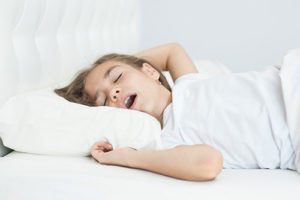Sleep Apnea in Children
Discover how sleep apnea affects children.
Though not as common as sleep apnea in adults, this obstructive breathing disorder can affect children as well. It’s important to know what symptoms to look for and when to get your child evaluated. Seeking treatment as soon as possible can help your child sleep better and correct the cause before they are an adult. Dr. Buchanan can help work with your child’s physician to help manage their sleep apnea, letting you both sleep better and wake up more alert.
Similar to adults, children face risk factors like obesity and a family history of sleep apnea. Children are also at risk of developing this serious breathing condition due to how the mouth and skeleton are developing. As a child’s jaws and mouths are still developing, causing factors including enlarged tonsils or adenoids, jaw size, and tooth position that can increase the likelihood that a child will suffer from pediatric sleep apnea.
Certain medical conditions including Down Syndrome and Cerebral Palsy can also increase a child’s risk of developing sleep apnea.
 Symptoms to Look For
Symptoms to Look ForIdentifying sleep apnea in children is particularly difficult. Kids often have a hard time expressing what is wrong and in many instances, the symptoms are mischaracterized as ADD or ADHD. Knowing the signs to look for can help ensure your child gets the treatment they need before sleep apnea starts to cause more serious health issues.
Some of the symptoms of pediatric sleep apnea include:
In school-age children with sleep apnea, the daytime fatigue and mood swings are often mischaracterized as disruptive behavior in school, or day dreaming. If your child’s teacher brings up these behaviors, it is a good idea to take your child to their pediatrician for a screening.
The best method of managing your child’s sleep apnea is seeking treatment early on. In most instances, children can use a CPAP machine. Long-term treatment should also be discussed to find what’s causing the obstruction. Early intervention braces may be recommended to realign the teeth if your child’s OSA is the result of a jaw that is too small. Diet changes and exercise may also be recommended to help treat underlying causes of sleep apnea.
To help parents provide children with the appropriate care, our San Rafael dentist works closely with fellow healthcare professionals throughout the region. Our goal is to work with you, the parent, to get your child a restful night’s sleep.
For most children who have the sleep apnea brought on by poor bite, jaw size, or tonsil size, treatments like tonsil removal and braces can help alleviate the symptoms by eliminating the cause of obstruction. Likewise, diet and exercise have been shown to help young patients whose sleep apnea is tied to the obesity. To learn more about pediatric sleep apnea and to explore your options, we strongly encourage you to schedule a consultation with your child’s physician for a diagnosis.